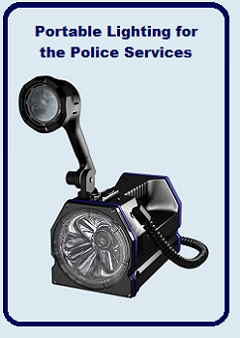In the 21st century “Bardic Lamp” is a generic term used to describe any signalling lamp in use on the railways.

Traditionally a “Bardic Lamp” was the name of a specific lamp made by British Chloride. The name “Bardic” now belongs to the electronic giant Honeywell, and is “dedicated to the design, manufacture and supply of products and systems which are used in making buildings safer around the world”
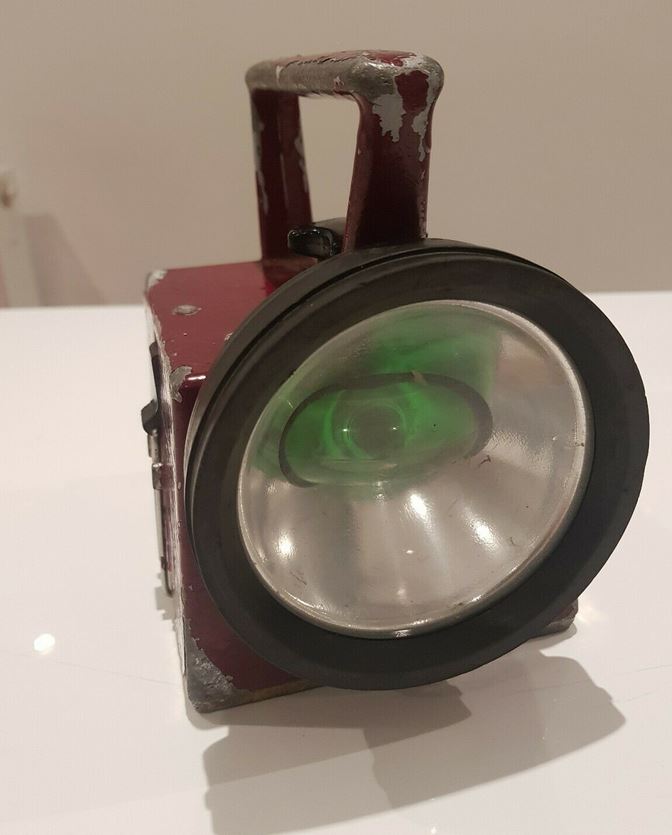
Referring to a hand-held signalling lamp as a Bardic lamp is similar to referring to a vacuum cleaner as a Hoover – it’s not quite accurate, but everyone knows what it means.
Hand held signalling lamps are still used in a similar fashion today. All that has changed, apart from the name, is the fact that the more modern versions are lighter, brighter and more durable. On the London Underground, Bardic lamps used to be placed on the stand on the offside console. Although the stand is still there it is no longer mandatory for the lamp to be placed there.
Although newer lighter “Bardic” lamps are now being manufactured, there are still a number of the original metal lamps to be found.
Bardic lamps are now used predominantly to signal the last train at night, and also to hold trains when necessary.
Most train staff carry a “Bardic” lamp as part of their regulation kit. In fact, the Network rail approved hand-held signalling lamp designed by White Knight, was done so at the request of a train operator who found the original lamps made the bags rather heavy.
Bardic lamps are carried so as to be available as emergency lighting on tracks, and also as a back up in case of failed lighting on the back or front of trains.
White Knight continues to improve hand-held railway signalling lamps. Advancements in technology have allowed us continuously improve the brightness, durability, battery life and overall weight of these lamps, as they continue to provide a vital service, even on our 21st century railways.
White Knight produce reliable and portable high powered illumination for the rail industry, ambulance and rescue, police and SOCO
White Knight deliver robust and reliable hand held lamps and torches for the emergency services. All White Knight products use high quality rechargeable battery systems to guarantee light when it is needed.
Have a look at our range:
Specialist Lamps
The HP-11 range of Personal Signalling Lamps features the latest advances in LED Technology. Each lamp features a high performance super bright LED array in up to three colour combinations – red, amber and green. All colours conform to BS 1376 signal colours. Other specialist colour requirements available on request.
Fingerprint Illumination for SOCO
The WKA-13 fingerprint illumination lamp emits a very bright even light designed specifically for Scenes of Crime Officers and Fire Investigators. Using the WKA-5 as a power source, this lamp can be held freely or used attached directly to the hand lamp via a mounting adapter, giving hands free operation with the ability to rotate and adjust the angle of illumination.
Heavy Duty Personal Lamps
Where guaranteed performance in non-hazardous situations is the criterion, the Halo Plus2™ provides a reliable way forward for the security services and transport industries.
Handheld Rechargeable Spot Lamp
The versatile Expert range is used by police, fire and ambulance services throughout the world
The best flashlights for emergency use are ones with a long battery life and a powerful beam.
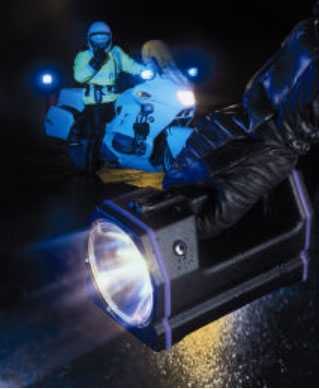 White Knight produce the WK Handlamp, a range of professional halogen rechargeable handlamps.
White Knight produce the WK Handlamp, a range of professional halogen rechargeable handlamps.
Made in the UK the WK-5 Trio is used by Emergency Services and Search and Rescue organizations worldwide.
Designed for long and short distance work, the Wk-5 range is a powerful torch that is moulded from high impact plastic to withstand the toughest conditions – durability that will last for years.
The Expert WK-5 range offers a comprehensive choice of models:
- 6, 10, 20 and 30 watt halogen outputs providing 55 mins to 14 hours of continuous illumination.
- High/Low and Flashing Beam Setting
- Low Battery Indicator
- Charge State Indicator
- Vehicle Battery Monitor
- Usage Monitor
- Auto Maintenance Charging
- Electronic Bulb Protection
- Mains Failure/Restore Monitor allows Expert WK-5 Trio to be used as an Emergency Portable Light Source
- Special versions using High Output LED Arrays are available for signalling purposes
- Environmentally friendly, fully protected Ni-MH Battery Pack
- Supplied complete with Mains Charger, Vehicle Charging Cord and Shoulder Strap
- Approved for use by the MOD and NATO forces.
A full range of plug-in accessories is available including: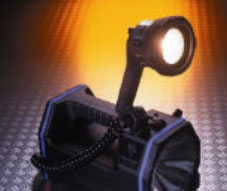
- Floodlighting
- Fingerprinting
- Ultra-violet and other lamps for forensic and close inspection use
White Knight have been producing rechargeable handlamps since 1976, and are constantly researching and developing their products.
 So, HS2 has been given the go-ahead! The first phase between London and the West Midlands has been given Royal Assent, ending four years of Parliamentary debates.
So, HS2 has been given the go-ahead! The first phase between London and the West Midlands has been given Royal Assent, ending four years of Parliamentary debates.
Construction of HS2 will begin within months after the £55.7 billion project was rubber-stamped, the government has confirmed.
The first phase of HS2 will run for 12 miles through Staffordshire as it passes Lichfield to join with the West Coast Main Line at Handsacre.
It is claimed that HS2 will create about 25,000 jobs during construction, and an additional 2,000 apprenticeships. There are suggestions that the wider economy could see growth of up to 100,000 jobs.
Read the details on gov.uk
There is still a lot of opposition with campaigners claiming it will cause irreversible damage to the environment. There is also the claim that the technology used by HS2 will be obsolete by the time it gets running by 2033.
Love it or hate it, it looks like finally happening
The Crossrail project is over 75% complete, and the final phases are moving along rapidly. To keep us up to date on what’s happening with Crossrail, Crossrail have produced regular videos detailing the most recent developments.
The most recent video sees Camilla Barrow, Project Manager, Railway Systems talks us through the track installation progress on the Elizabeth line which is due to open in December 2018.
Crossrail have a comprehensive collection of videos on youtube detailing its progress.
The Crossrail website also has some interesting news updates including information on Central station updates, the new trains being tested in Derby. Find out more about Ilford station’s revamped ticket hall, and the latest on Farringdon station.
All in all a fascinating look at Crossrail, even for those not in the industry
Rolls-Royce has officially opened a redesigned and upgraded facility in Cape Town, South Africa, where 232 MTU engines destined for rail will be assembled, tested, painted and commissioned.
Rolls-Royce has invested about R50-million (£3 million)in upgrading and revamping the facility to be able to localise the manufacturing of the engines. MTU South Africa is a subsidiary of MTU Friedrichshafen, the core business of Rolls-Royce Power Systems, a division of Rolls-Royce plc.
The MTU brand develop and produce large high-speed engines and propulsion systems for ships and heavy land, rail and defence vehicles, as well as drive systems for use in the oil and gas industry and in power generation. Our diesel engines and gas engines are capable of power outputs up to 10,000 kW and 2,535 kW respectively. MTU also supplies customized electronic automation and control units for its engines and propulsion systems.
The deal for the 232 engines is one of the largest rail orders in MTU’s history.
Rolls-Royce will supply the 20-cylinder Series 4000 R63L model engines, with a power output of 3 300 kW, to the China Railway Rolling Stock Corporation (CRRC), which will manufacture the locomotives. The Class 45 locomotives will then be delivered by CRRC to the TFR.
“This is a big moment for South Africa. We are very proud to be the manufacturer within this huge Transnet procurement process. We have a clear vision to make a positive difference through better power for a changing Africa,” said MTU South Africa CEO Andrea Nono.
Speaking at the launch of the upgraded facility, in Montague Gardens, Cape Town, Nono said that the company would take on an additional 20 people for the project, which has also established a new training centre where intensive training for staff at MTU South Africa has been provided.
Employees were also sent to the MTU head office in Friedrichshafen, Germany, for skills transfer training courses that lasted two months. This helped employees gain practical experience in assembling, painting and testing the engines.
Nono said the engines were state-of-the-art and extremely powerful, but fuel-efficient at the same time.
“Picture eight Ferraris. That would give a similar output to one of our engines, although [our engines] are more condensed and fuel-efficient,” Nono told the launch.
She told Engineering News Online that the new facility was a significant move for MTU South Africa, which is celebrating its fifteenth anniversary this year. Prior to the Transnet order, the company serviced customers mainly in the mining and marine sectors.
“Our whole business model has changed in South Africa. We were a sales and service company for Rolls-Royce products, but now we are adding a whole new layer,” said Nono.
She added that MTU saw itself as an active partner in the further development of South Africa’s manufacturing industry.
Meanwhile, MTU industrial business VP Bernd Kruper noted that the company had plans to expand into sub-Saharan Africa.
“Africa is an extremely interesting market for us and one in which we see enormous growth potential. We regard the upgrading of our facility in Cape Town as an important strategic step towards deepening our partnership with customers in Africa,” he said.
The MTU facility has been upgraded in various ways. For instance, a new ultramodern paint booth, designed to use environment-friendly paints, has been installed. The revamping also includes the upgrading of the test bench, the assembly and logistics areas, as well as the acquisition of new overhead cranes.
White Knight are proud to supply trackside lighting to the rail industry. Call us on 023 9266 8624 for all your signalling and bardic lamp requirements.
White Knight have been manufacturing Network Rail approved signalling lamps for over 25 years.
One of the major train operating companies (TOC) was concerned that the weight of the train driver’s bag was becoming a health and safety issue. This was partly due to the weight of the original bardic lamps that train drivers carried.
White Knight responded by designing and producing the hugely successful Halo personal signalling lamp. Not only was it significantly lighter than the original Bardic lamp, it was also much brighter.
The Halo range of hand-held signal lamp is approved by Network Rail (Cert. No. PA/05/965) and still widely used and trusted within the rail industry.

The Halo range includes:
Halo Plus2™ Personal Signalling Lamps
The HP-11 range of Personal Signalling Lamps features the latest advances in LED Technology. Each lamp features a high performance super bright LED array in up to three colour combinations – red, amber and green. All colours conform to BS 1376 signal colours. Other specialist colour requirements available on request.
HP-11R3RT –White halogen torch incorporating Red / Amber / Green LED signal lamps
HP-11R3 –White halogen torch incorporating Red / Amber / Green LED signal lamps
HP-11R2 – White halogen torch incorporating Red / Green LED signal lamps
HP-11R – White halogen torch incorporating a Red LED signal lamp
Personal Rechargeable Hand Lamps
Halo Plus2™ Torch – Industry standard rechargeable halogen torches providing a light-weight compact hand held lighting solution.
WK5 Hand Lamp – Professional halogen rechargeable hand lamps that are powerful, rugged and versatile, giving years of reliable and trouble free service.
White Knight is best known for its range of rechargeable handlamps. The ‘White Knight’ range was developed after extensive research. The Halo Plus torch is Network Rail approved, and the Halo Plus 2 lamp has been in production since 1990. It is used by the British, German and Swiss rail networks, as well as the Eurostar service and infrastructure companies.
White Knight is currently a market leader in the supply of specialised lamps to “Blue Light Services”, Rail Networks, Military and Public Utilities worldwide. White Knight holds BS EN ISO 9001 certification, and the company has also achieved a range of industry standards and certification.
Bespoke Product Design for Rail and Emergency Services
From time to time there will be a request from clients to design and develop bespoke lighting products for a specific industry or application.
These include :
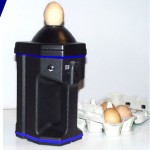 WK Egg Candling Adapter – a portable rechargeable solution (230V or vehicle) is effective in illuminating eggs for disease detection and is simplicity itself to set up and use. It has been in use by egg inspectors at the Department of the Environment, Food and Rural Affairs (DEFRA) for many years proving to be an unqualified success.
WK Egg Candling Adapter – a portable rechargeable solution (230V or vehicle) is effective in illuminating eggs for disease detection and is simplicity itself to set up and use. It has been in use by egg inspectors at the Department of the Environment, Food and Rural Affairs (DEFRA) for many years proving to be an unqualified success.
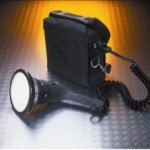 100 Watt Portable Flood Lamp Kit – Developed in conjunction with major police forces the ‘SL-50’ and ‘SL-501’ combination provides a powerful hand held white halogen floodlight kit for personal use. Ideal for SOC, Photography, Search, Accident Investigation and other situations.
100 Watt Portable Flood Lamp Kit – Developed in conjunction with major police forces the ‘SL-50’ and ‘SL-501’ combination provides a powerful hand held white halogen floodlight kit for personal use. Ideal for SOC, Photography, Search, Accident Investigation and other situations.
 Conelight – a compact lightweight traffic cone beacon designed for use by all ‘blue light’ emergency services. Conelight uses the latest LED technology to provide outstanding performance and rapid dispersion. The brilliant flash is visible even in daylight. Designed to give improved stability in wind and passing traffic, the beacon uses its battery pack to provide the cone with an extremely low centre of gravity.
Conelight – a compact lightweight traffic cone beacon designed for use by all ‘blue light’ emergency services. Conelight uses the latest LED technology to provide outstanding performance and rapid dispersion. The brilliant flash is visible even in daylight. Designed to give improved stability in wind and passing traffic, the beacon uses its battery pack to provide the cone with an extremely low centre of gravity.
Talk to White Knight if you have a specific need for portable lighting within your industry. Call +44 (0)23 9266 8624
As the Seinne subsides and Paris gets back to normal, one of its biggest ever rail projects gets under way.
The €25bn Grand Paris Express metro began on June 4 with a ground-breaking ceremony at the site of the future Fort d’Issy-Vanves-Clamart station.
The first phase of the project, Line 15 South, will see 16 stations linking the southern suburbs of Paris. This phase is scheduled for completion in 2022 at a cost of €5.7bn. The project is being overseen by Société du Grand Paris (SGP), who will be co-ordinating over 1500 engineering experts.
The new Grand Paris Express Line 15 should see over 200km of new line and 68 new stations. There will be trains of 2.80m wide and 108m long travelling at speeds of up to 120 kph. It is anticipated that the new 33km line will carry about 300,000 passengers every day with a projected morning rush of up to 34 560 passengers per hour.
This project is technically challenging, and will do much to ease the economic, social and cultural issues that are caused by the current public transport limitations.
Plans drawn up in January 1945 have been found in an archive of historical documents. These plans were discovered by engineers working on the design of the proposed Visitors Centre at the Forth Bridge.
Although the plan bears a resemblance to the Sydney Harbour Bridge which was built in 1932 it is almost 3 times bigger and features 110m arches and 70m masonry towers.
The drawing is attributed to the ‘Engineers Department Edinburgh’ and is dated 22 January 1945. The bridge was never built and the plans disappeared in obscurity which suggests that it might have been drawn up as a back-up plan in case the existing bridge was attacked and destroyed during World War II.
This is just speculation, and Network Rail, who own the Forth Bridge and VisitScotland are appealing for anyone with information about the plans to help solve the mystery.
Ian Heigh, a senior project manager for Network Rail, said: “To be honest, even Network Rail’s longest serving railway engineers seem to be a bit perplexed by the true purpose of these proposals. If this bridge had been built, the entire character of the area would have altered, not just the famous landmark. We’d love to know more about these plans, so I’d encourage anyone with more information to get in touch.” Any information can be sent to: info@forthbridgeexperience.com.
The Forth Bridge is now a world heritage site and the proposals for a visitor’s centre ‘The Forth Bridge Experience’ can be seen here.





